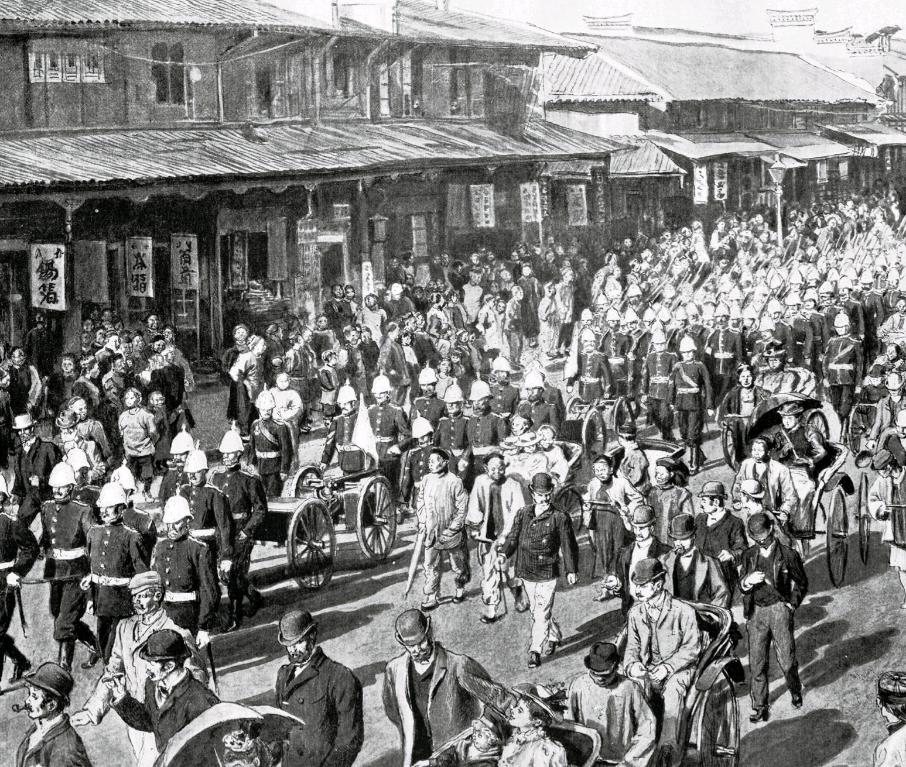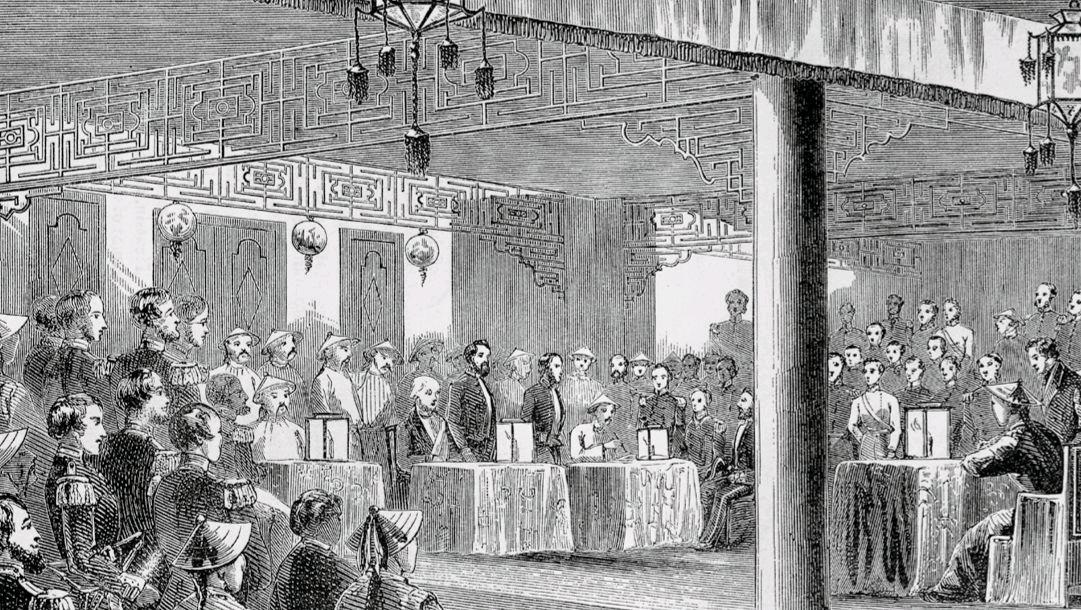Western Witnesses of the First Sino-Japanese War
by+Ni+Juncheng
“Thank God it is not at our doorstep but in the Far East that we learned how powerful the latest generation of warships and engines are. You are sorely mistaken if you still think Asians are still pasting dragons on their backs and carrying bows onto battlefields… Have you seen this? In Japan, a magnificent war has broken out, arousing great envy from European countries.”
This is an excerpt of an editorial published in the French newspaper Le Petit Journal on August 13, 1894. The First SinoJapanese War marked a turning point in the history of international relations in contemporary East Asia. For the first time, Western media began to focus on the Far East, a region that, ever since, has drawn attention from Western countries seeking global expansion. The war drastically changed the international landscape.
Worldwide Concern for Far East
In 2012, several history-minded Chinese journalists started searching old newspaper reports from foreign countries such as Britain, France, Russia, and the United States as they worked in those countries. After gathering more than 1,000 old newspaper reports dating from 1840 to the beginning of the 20th Century, they published the book, 1894: In the Eyes of Western Media 120 Years Ago, under the name “Universal Newspaper Office”, aiming to illustrate China in the eyes of foreigners a century ago.
In the late 19th Century, newspapers were still mostly popular with the aristocratic class. In addition to professional journalists, diplomats and senior officers also contributed to newspapers. Along with the advancement of plate printing techniques, vivid illustrations of East Asian countries began to appear in Western newspapers. Despite addressing different topics from contrasting angles and analyzing international situations in a variety of ways, Western media organizations produced a massive information network on the Far East.
At the time, Western media had dubbed Korea the “hermit nation.” In A Glance at Korea published in The Illustrated London News on August 4, 1894, the author describes Korea as a “strange, secluded nation that lives on a peninsula between Chinas Yellow Sea and the Japanese Islands. Although they cannot be seen as barbarians, the land is the furthest from modern civilization and least influenced by the reform spirit of Europe. For many years, the nation has refused to trade and communicate with the outside world and even resisted the reforms that its powerful neighbors are carrying out.”
Japan wholeheartedly embraced Western values and thus received a warm welcome from Western countries. In an essay in Harpers Weekly, U.S. Navy Paymaster-General Eustace B. Rogers wrote, “With great curiosity, Japanese living beyond treaty ports politely call foreigners ‘stranger sang or ‘Mr. Foreigner. They carefully observe foreigners behavior, which they consider very strange, and enjoy doing so. Foreigners ages, habits and hobbies all become topics for discussion.” The “civilized and open” image of Japan in Western media was partially caused by a sense of intimacy and recognition that Americans held for Japan. Some Americans even considered the Japanese “Eastern Yankees.” Of course, this was likely also greatly influenced by the Japanese governments strategies toward mass media.
According to the Universal Newspaper Office, the Japanese government invited more than 100 journalists, illustrators, and photojournalists, including several from Western media, as correspondents to cover the First Sino-Japanese War.
Conversely, the West was still panicked about China as the“Yellow Peril” trend persisted through the late 19th Century. On December 19, 1891, Le Petit Journal began publishing a series of illustrated reports depicting “massacres of Westerners in China.”Members of the Universal Newspaper Office believe that the French newspapers bias towards China evidences Western countries starkly contrasting attitudes towards China and Japan at the time. In this context, its easy to understand why Western media showed little sympathy for China as a victim of the First SinoJapanese War. Despite decent relations with the Qing Dynasty(1644-1911), the United States enacted the Chinese Exclusion Act in 1882 to ban immigration from China. In 1895, German emperor Wilhelm II even personally designed a painting titled The Yellow Peril. Historians point to many factors leading to the emergence of the “Yellow Peril” trend, including but not limited to: Western countries looking for pretext for oppression and invasion of East Asia, overseas Chinese laborers driving wages down, Western countries attempting to shift economic crises to Eastern countries, and foreign missionaries being scorned and even attacked in China.
“It Was a Cold-blooded Butchery.”
“Since the extraordinary revolution, upon the decree of the Emperor of Japan, the Japanese have made up their minds to dis- card their own civilization and embrace European civilization. The war that Japan has launched against its gargantuan neighbor proves its reform unexpectedly impressive. Some Tokyo photos that we have received show the revival of Japan even more radical than imagined, which has even expanded to the field of humanitarianism.”
This paragraph was published in a report in the French weekly LIllustration on December 29, 1894. The “revival in the field of humanitarianism” actually refers to the fact that the Japanese army allowed war correspondents to visit its prison camps and field hospitals, so as to showcase their world-class medical aid system and benevolent treatment of prisoners. Taking advantage of Western media, Japan created a civilized, developed image of itself by the end of the 19th Century. However, such an image starkly contrasts the crimes committed in the Lushun (Port Arthur) Massacre when Japan took the port city in November 1894.
Members of the “Universal Newspaper Office” team found that James Creelman, a journalist from New York World, worked as a war correspondent with the Japanese 2nd Army during the First Sino-Japanese War. On November 24, 1894, four days after the Port Arthur Massacre, Creelman became the first Western journalist to report on the event. He said: “I can say as an eye witness that the wretched people of Port Arthur made no attempt to resist the invaders… I saw a man who was kneeling to the troops and begging for mercy, pinned to the ground with a bayonet while his head was hacked off with a sword.”
For fear that the Japanese might confiscate his reporting about the massacre, Creelman delivered two copies via different channels. His reports didnt reach the New York World office until December 19, 1894. The following day, his essay The Massacre at Port Arthur was published after editing by Joseph Pulitzer, thenpresident of New York World and the namesake of the top award in journalism who later also founded the Columbia University Graduate School of Journalism. In the essay, Creelman wrote: “The struggle for the emancipation of Corea [Korea] suddenly turned into a headlong, savage war of conquest. It is no longer a conflict between civilization and barbarism. Japan has dropped her mask and for the last four days has trampled civilization under the feet of her conquering army.” In addition to Creelman, journalists from British newspapers The Times, Evening Standard, and Black & White also covered the massacre at Port Arthur.
In March 1895, Northern American Review (vol. 160) published The Truth about Port Arthur by Frederic Villiers, in which he wrote: “On the third evening of the butchery, Mr. Ariga, a gentleman attached to the Field Marshal [ōyama Iwao] as an advi-sor on international law, and an excellent English scholar, called on the war correspondents at the Yamen, in Port Arthur… When Mr. Ariga was seated, he turned to me and said: ‘Mr. Villiers, please speak without any hesitation. Would you call the trouble of the last three days a massacre? It was a startling question coming from a Japanese official. I looked at my colleagues, Messrs, Creelman, Cowen and Hart, who were also much astonished at the question, and then I answered: ‘Well, Mr. Ariga, that expression was one that might not quite apply to the case. I told him that the first days provocation was almost an excuse for the conduct of the troops, but that the last two days work might carry another term. Luckily, Mr. Ariga did not ask me what that might be, but I had contemplated, and eventually called it a cold-blooded butchery. It was a coldblooded butchery.”
As soon as they were published, stories about the Port Arthur Massacre by Western journalists including Creelman shocked English and American readers. The Japanese government used every means to defend itself, published essays to excuse its crimes in Western newspapers, and smeared journalists who revealed the truth, including Creelman. However, the Qing government kept silent about the massacre. Due to their own interests, British and American governments ignored the event. Therefore, the bloody Port Arthur Massacre didnt stir up much concern in the international community at that time.
Mixed Motives of Western Countries
“Russian warships are sealed in ice and snow in Vladivostok harbor for months each year. Russia has long preferred Koreas icefree ports. Britain asserts that it will take over Hamilton Island if Russia doesnt protect it. The United States has also declared that it needs to protect its business interests in Korea.”
That was how Le Petit Journal commented major powersinterests in East Asia in a report dated August 13, 1894. Several days earlier, on July 30, 1894, French diplomat Fran?ois Deloncle published an essay in Le Matin criticizing Britain, in which he said: “Britain doesnt feel guilty about pushing its ally, China, into a predicament. On the contrary, it is preparing to fish in troubled waters. For instance, it launched demarcation of the borders between Yunnan Province and its colony India, invaded Tibet, and more importantly, retook Port Arthur at the mouth of Bohai Bay and Koreas Hamilton Island at the throat of the Joseon Straits. It doesnt disguise its intentions to impede the rise of Russia because the quiet growth of Russias influence on the Sea of Japan and the China Sea has worried Britain.”
On October 20, 1894, Harpers Weekly published an essay titled Russias Interest in the Far East, which said, “Over the past several years, when Russia dispatches a warship to the Pacific, Britain immediately sends two equivalent warships to the same waters. It is reported that the French navy recently also took action and expressed sympathy for Russia.”
The 1,000-plus articles from old newspapers compiled by members of the Universal Newspaper Office create a comprehensive look at East Asia at the time. “In our textbooks, Western imperialist powers are described as allies,” one member illustrates.“After reading foreign newspapers of the time, you realize that they also competed with each other and had different interests.”

In preparation for a speech at the Seminar in Commemoration of the 120th Anniversary of the First Sino-Japanese War held this September in Weihai, Shandong Province, Chinese scholar Liu Huanming conducted in-depth analysis of the U.S. stance towards the First Sino-Japanese War. He remarked that during the war, the United States adhered to its “isolationism” strategy for East Asia issues it adopted in the 1870s and refused to cooperate with European countries in intervening in the First Sino-Japanese War for fear of helping European countries expand their influence in East Asia. Moreover, the United States was the only country in the world to condemn Japan for the Port Arthur Massacre. On December 15, 1894, U.S. envoy to Japan Edwin Dun sent a diplomatic note to the Japanese government declaring that if it “doesnt take appropriate remedial measures for the Port Arthur Massacre, the reputation Japan has earned will be completely ruined, which will be highly regretful.” Under pressure from the United States, the Japanese government later issued a statement, in which Japan admitted that “Port Arthur undoubtedly saw more blood than needed,” although it continued denying any war crimes had been committed. As proof of the Port Arthur Massacre, the statement remains important today.
China Pictorial2014年10期
